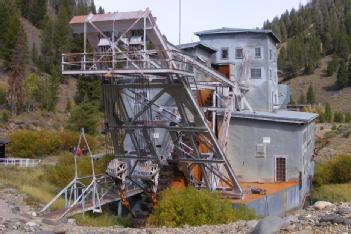
Yankee Fork gold dredge |
83278 Stanley, ID, United States of America (USA) (Idaho) |
|
| Address |
300 Yankee Fork Rd
|
| Floor area | unfortunately not known yet |
|
Opening times
|
|||||
|
Status from 11/2017
|
We don't know the fees. | ||||
| Contact |
|
||||
| Homepage | yankeeforkdredge.com | ||||
| Location / Directions |
The dredge is located in the central mountains of Idaho close to the Frank Church River of No Return Wilderness Area. The nearest town is Stanley which is 22 miles from the dredge. From Stanley take Hwy 75 east to Sunbeam (13 miles) then turn north and follow the Yankee Fork river 10 miles to the dredge. The dredge sits on the left side of the road. Once you leave paved road, you’ll see dredge tailings along both sides of the road, reminders of the path the dredge traveled during its years of operation. From Challis take Hwy 75 west to Sunbeam (42 miles from junction of 75 and 93) then right 10 miles to the dredge. Before you leave Challis be sure to stop at the Land of the Yankee Fork State Park which includes an Interpretive Center that is run by Idaho Parks and Recreation Department. Mileage from some key areas: Boise to the Dredge = 150 miles Idaho Falls to the Dredge = 182 miles Twin Falls to the Dredge = 164 miles West Yellowstone to the Dredge = 288 miles |
| Description | The Yankee Fork gold dredge operated into the 1950s, near Custer. It was powered by two 350 horse Ingersoll-Rand, 7 cylinder diesel engines, burning 400 to 500 gallons of fuel a day. A gold dredge is a placer mining machine that extracts gold from sand, gravel, and dirt using water and mechanical methods. A large gold dredge uses a mechanical method to excavate material (sand, gravel, dirt, etc.) using steel "buckets" on a circular, continuous "bucketline" at the front end of the dredge. The material is then sorted/sifted using water. On large gold dredges, the buckets dump the material into a steel rotating cylinder (a specific type of trommel called "the screen") that is sloped downward toward a rubber belt (the stacker) that carries away oversize material (rocks) and dumps the rocks behind the dredge. The cylinder has many holes in it to allow undersized material (including gold) to fall into a sluice box. The material that is washed or sorted away is called tailings. The rocks deposited behind the dredge (by the stacker) are called "tailing piles." The holes in the screen were intended to screen out rocks (e.g., 3/4 inch holes in the screen sent anything larger than 3/4 inch to the stacker). |
[dsp_museum_detail.cfm]
| Data Compliance | More Information |

